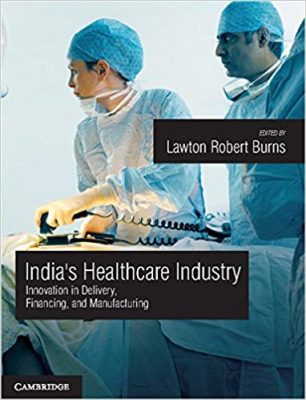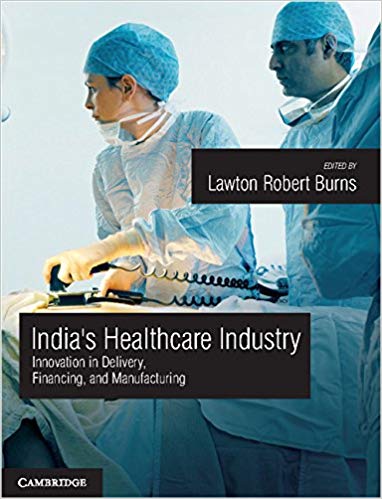 Editor: Lawton Robert Burns
Editor: Lawton Robert Burns
Publisher: Cambridge University Press – 580 pages
Book Review by: Nano Khilnani
In order to realistically understand India’s healthcare industry, we need to get a broad view of its economy and compare it with another large and populous country – China, with over a billion healthcare consumers; and with the world’s oldest democracy – the United States, with India being the largest. This book provides a comparison and contrast between India’s healthcare system and that of the United States but not with that of China.
Take note that there are two ways to compare the economy of a country with another, and they are to look at its Gross Domestic Product (GDP) on a nominal basis, with the US dollar as the yardstick, and on a purchasing power parity (PPP) basis, with a given country’s currency as the yardstick. So here’s how India’s GDP stood on both bases in 2017, according to the International Monetary Fund (IMF). :
- On a nominal basis India’s total GDP of $2.611 trillion is the world’s sixth largest after the United States, China, Japan, Germany, and the United Kingdom. The US GDP is $19.391 trillion, and No.5 UK’s is $2.625 trillion
- On a PPP basis, India’s total GDP of $9.459 trillion is the world’s third largest, after the United States’ $19,391 trillion (same as nominal GDP because the US dollar is the measuring tool) and China’s GDP of $23.169 trillion on a PPP basis
The real measure however of how well a country’s people are doing financially is its GDP per capita on a nominal basis, meaning how much does the average person in a given country earn in a year? Furthermore, the nominal GDP on a per capita basis provides the true measure of comparison with people in different countries.
By this measure, Luxembourg tops the list, where the average person there earned $105,803 in 2017, followed by Switzerland, Macau, Norway, Ireland, Iceland, Qatar, the United States, Singapore, Denmark, and No.10 Australia, with average per capita earnings of $56,444.
On the PPP per capita basis, none of the countries mentioned above are among the top 10. The United States ranks No.11, where the average person earned $59,495 in 2017. The top 10 (with some sharing a rank) are: Qatar (average income $124,927) followed by Macau, Luxembourg, Singapore, Brunei, Ireland, Norway, Kuwait, United Arab Emirates, Switzerland, Hong Kong, and San Marino, with $60,359 as per capita income in 2017.
High ranking in per capita annual earnings or income on a PPP basis simply means that the average person in that country makes enough money to live well in that country. But high ranking on a per capita nominal basis means if an individual were to travel to another country that also ranked high on that score, he or she would not “feel the pinch” with the cost of a typical basket of goods and services.
India ranks very low worldwide on both bases. On a nominal per capita basis, it ranks No.140 among 188 countries, with just $1,983 being earned in a whole year by the average person in 2017. On a PPP basis it also ranked a low No.122, with $7,174 earned, which is good if you live in India, but would put you into the poverty level if you lived in the United States, for example.
We are mentioning these amounts because many of our readers are among the 5.2 million South Asians living in the United States, and of those people, there are 155,000 Indian doctors, who work in the US healthcare industry.
So here below, as we typically provide you at the beginning of book reviews, is a list of the Sections and chapters that constitute this book:
- Section I. Introduction: Lessons and Frameworks for Analyzing India’s Healthcare System
- India’s Healthcare Industry: A System Perspective
- Innovative Responses to the Healthcare Challenges Confronting India
- India’s Healthcare Industry: An Overview of the Value Chain
- Section II. Providers: Delivery of Healthcare Services
- The Medical Profession in India
- India’s Hospital Sector: The Journey from Public to Private Healthcare Delivery
- Medical Tourism: Opportunities and Challenges
- The Aravind Eyecare System
- The Real Deal at L.V. Prasad Eye Institute: Excellence and Equity in Healthcare
- Vaatsakya Healthcare: Promoting Healthcare in Rural and Semi-Urban India
- Section III. Payers: Financing of Healthcare Services
- The Health Insurance Sector in India: History and Opportunities
- Providing Care to the Bottom of the Pyramid
- Opportunities in Healthcare Private Equity in India
- Section IV. Producers: Manufacturers of Healthcare Technology
- The Indian Pharmaceutical Sector: The Journey from Process Innovation to Product Innovation
- India’s Biotechnology Sector
- The Medical Device Sector in India
- Balancing Access and Innovation in Developing Countries
These are among the salient points made by the editor Lawton Robert Burns on India’s healthcare industry, and in order to provide the best representation of his conclusions, we quote him
- The Iron Triangle of Healthcare (Balancing Act Among Intermediate Outcomes) consisting of Cost Containment, High Quality Care, and Patient Access – is the ideal or desired situation, but India, just like the United States, faces challenges in achieving all these three outcomes
- Cost – Nearly 70 percent of all healthcare is financed out of pocket by consumers, and there is little health insurance, little regulation and accountability of providers, and a predominance of fee-for-service payment, all of which are associated with high costs There is also questionable efficiency of the roughly 30 percent of the healthcare system financed by government sources, and great distrust of the public sector overall
- Quality – There is little regulation of providers, treatments, and medical products (often from spurious sources), considerable variation in the education and training of providers, and little enforcement of laws and regulations at the state level
- Access – A substantial majority of the population dwells outside of the cities where most healthcare facilities exist. Access is also particularly problematic for the poor, low-income population, women, and marginalized groups.
It is a formidable situation in India to achieve all of the three elements of the desired outcome, so most economists in India believe that trade-offs must be made. Marketers of healthcare services and products contend that they must excel in one dimension – product cost, quality, or service.
This book provides a lot of quality information, analysis, and insight about the healthcare industry in India. This would otherwise have not been able to be accessed thoroughly,or presented impartially as an outsider looking in,if someone else other than the editor, who has had decades of experience as a healthcare administrator, would have undertaken this massive project.
Little is known about the healthcare industry in India, and this book marks an excellent beginning. There is much that is good about India’s healthcare system – such as providing relatively low-cost surgeries to people in the United States where costs are prohibitive – but there is much also that needs to improve in India, such as providing wide access to the hundreds of millions of poor people in India’s villages.
Editor:
Lawton Robert Burns is James Joo-Jin Kim Professor and Chair of the Health Care Management Department at the Wharton School, University of Pennsylvania. He is Director of the Wharton Center for Health Management and Economics and a Co-Director of the Roy and Diana Vagelos Program in Life Sciences and Management at the University of Pennsylvania.







